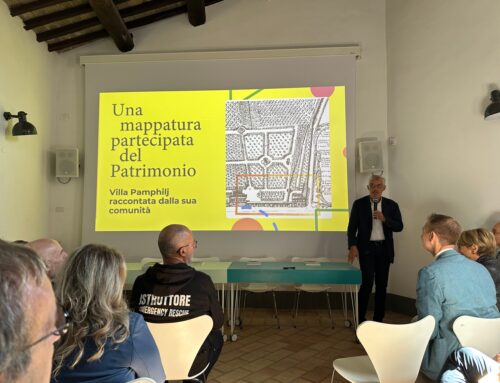Workshop at Villa Pamphilj: Co-Design for a Sustainable Future.
On Dec. 6, 2024, the community of Villa Pamphilj gathered at the Casale dei Cedrati for a transformative co-design workshop entitled “Tracciamo insieme il futuro.” This event, held under the auspices of the CHANGES project – Cultural Heritage Active Innovation for Next Generation Sustainable Society – was a significant step toward promoting community activation and sustainable heritage practices. Villa Pamphilj Sustainable Co-Design is at the center of this commitment to the future.
Workshop Highlights
Starting from the results of the survey, the aim is to strengthen the involvement of social and cultural associations and organizations in the target area in the participatory construction of interventions aimed at enhancing and encouraging the active and conscious enjoyment of cultural and public heritage.

- Empathy Map: A tool for community members to express their desires and map out significant sites within Villa Pamphilj. Empathy map is the contribution of people with their inputs via an interactive survey (accessible here) and visualized the collective insights on the dedicated dashboard (view the dashboard). The map was created by gisAction to help people have better engagement and understand their community.
- Heritage Map: A detailed inventory of the cultural and natural heritage of Villa Pamphilj, showcasing the richness of the area. This map underscores the importance of preserving and promoting these assets, linking the community’s history with its future.
- Stakeholders Map:A representation of the key stakeholders who play a fundamental role in shaping and supporting initiatives within Villa Pamphilj. This map fosters collaboration and transparency among those involved in the development and promotion of the area. gisAction played a key role in its development, ensuring clarity and accessibility to all stakeholders. (Go to survey)
The Co-Design Process
After the presentation of the maps, participants took part in thematic work tables facilitated by the teams of experts from Eticae and Prospects. Activities were conducted using the World Café methodology, focusing on specific topics:
- Security, access and accessibility;
- Cultural activities, sports and green spaces.
Participants took part in both tables in rotation, reflecting on the initial results of the Community Activation (survey) project. The goal of this co-design action was to surface needs, resources and activities to be made available, along with proposals for developing future collaborative initiatives. During the sessions, participants identified priorities, critical aspects and challenges, putting forward ideas and proposals; some more concrete, others more general; to improve the livability of Villa Pamphilj, increase the ways in which it can be used and improve its safety and accessibility. The activity ended with a final convivial moment, over tea and cakes, during which the facilitators summarized and returned to all participants the results that emerged from the two working tables.
Why This Matters?
The initiatives discussed and designed during the workshop have far-reaching implications:
– Empowering the community: Tools such as the Empathy Map give the community a voice, ensuring that development aligns with the needs and aspirations of local residents.
– Preserving cultural heritage: The Heritage Map serves as a cornerstone for safeguarding Villa Pamphilj’s historic and natural treasures.
– Improve collaboration: The Stakeholder Map highlights the interconnected roles of municipalities and organizations, paving the way for more cohesive planning and execution.
Looking Forward
Reflecting on the results of this workshop, it is clear that the co-design process has sown the seeds for a sustainable and inclusive future. This future includes the green cultural district, the result of the debate and proposals that emerged during the workshop, which will feed into the overall project for the enhancement of Villa Pamphilj. The cultural heritage of Villa Pamphilj is not only a testimony to its past, but also a beacon guiding its path into the future. The CHANGES project, supported by NextGenerationEU, is an example of how innovative, community-driven approaches can lead to significant and lasting impacts.
In line with this effort, CoopCulture announces that the results of the workshop will soon be shared, alongside the next steps to broaden participation and invite more actors interested in becoming active contributors to this initiative.
For those interested in exploring the heritage map further, visit the comprehensive resource at Casale dei Cedrati. Additionally, immerse yourself in the narratives and aspirations of this project via the Story Map.
Together, we’re not just mapping the present but envisioning a future where Villa Pamphilj remains a vibrant, cherished, and sustainable hub for generations to come.











